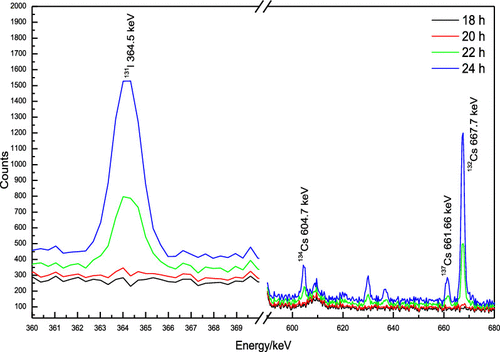当前位置:
X-MOL 学术
›
ACS Earth Space Chem.
›
论文详情
Our official English website, www.x-mol.net, welcomes your
feedback! (Note: you will need to create a separate account there.)
Analysis of the Dispersion Timeline and Isotope Activity Ratio Characterization of Airborne Radionuclides Released from the Fukushima Daiichi Nuclear Power Plant Accident
ACS Earth and Space Chemistry ( IF 2.9 ) Pub Date : 2021-09-17 , DOI: 10.1021/acsearthspacechem.1c00271 Shilian Wang 1 , Qi Li 1 , Xinjun Zhang 1 , Yuanqing Fan 1 , Yungang Zhao 1, 2 , Huaimao Jia 1 , Zhanying Chen 1 , Yinzhong Chang 1 , Shujiang Liu 1 , Jianfang Shi 1 , Yuchen Zhu 1, 3 , Shaohang An 1 , Zhi Zeng 4 , Junli Li 4
ACS Earth and Space Chemistry ( IF 2.9 ) Pub Date : 2021-09-17 , DOI: 10.1021/acsearthspacechem.1c00271 Shilian Wang 1 , Qi Li 1 , Xinjun Zhang 1 , Yuanqing Fan 1 , Yungang Zhao 1, 2 , Huaimao Jia 1 , Zhanying Chen 1 , Yinzhong Chang 1 , Shujiang Liu 1 , Jianfang Shi 1 , Yuchen Zhu 1, 3 , Shaohang An 1 , Zhi Zeng 4 , Junli Li 4
Affiliation

|
The dispersion timeline and the specific ratio characterization of airborne radionuclides released from the Fukushima Daiichi Nuclear Power Plant accident were investigated based on an analysis of the monitoring data obtained from regional stations and radionuclide stations of the International Monitoring System for the Comprehensive Nuclear-Test-Ban Treaty. The comprehensive temporal sequence of airborne radionuclide arrival time at different sites was given, including xenon, iodine, and cesium isotopes, which could be used to validate and evaluate atmospheric transport modeling. Based on the decay time estimation method, the release time and process of radionuclides were calculated and analyzed through activity ratios of 133I to 131I, 136Cs to 137Cs, and 134Cs to 137Cs. It indicated that radioiodine isotopes leaked from the reactors in the early stage after the 2011 Great East Japan Earthquake occurred, and there were two sources which leaked radiocesium, one is units 1, 2, and 3 of the Fukushima Daiichi NPP and the other is the spent fuel pools with a high possibility. Generally, this study provides some valuable findings and information for further evaluation of the accident and relevant research work.
中文翻译:

福岛第一核电站事故释放的气载放射性核素的弥散时间线和同位素活度比表征分析
基于对全面禁止核试验国际监测系统区域站和放射性核素站监测数据的分析,研究了福岛第一核电站事故释放的气载放射性核素的弥散时间线和具体比例特征条约。给出了不同地点的航空放射性核素到达时间的综合时间序列,包括氙、碘和铯同位素,可用于验证和评估大气传输模型。基于衰变时间估计法,通过133 I 与131 I、136 Cs 的活度比计算和分析放射性核素的释放时间和过程。137 Cs 和134 Cs 至137 Cs。表明2011年东日本大地震发生初期反应堆放射性碘同位素泄漏,放射性铯泄漏源有两个,一个是福岛第一核电站1、2、3号机组,另一个是乏燃料池的可能性很高。总的来说,这项研究为进一步评估事故和相关研究工作提供了一些有价值的发现和信息。
更新日期:2021-10-22
中文翻译:

福岛第一核电站事故释放的气载放射性核素的弥散时间线和同位素活度比表征分析
基于对全面禁止核试验国际监测系统区域站和放射性核素站监测数据的分析,研究了福岛第一核电站事故释放的气载放射性核素的弥散时间线和具体比例特征条约。给出了不同地点的航空放射性核素到达时间的综合时间序列,包括氙、碘和铯同位素,可用于验证和评估大气传输模型。基于衰变时间估计法,通过133 I 与131 I、136 Cs 的活度比计算和分析放射性核素的释放时间和过程。137 Cs 和134 Cs 至137 Cs。表明2011年东日本大地震发生初期反应堆放射性碘同位素泄漏,放射性铯泄漏源有两个,一个是福岛第一核电站1、2、3号机组,另一个是乏燃料池的可能性很高。总的来说,这项研究为进一步评估事故和相关研究工作提供了一些有价值的发现和信息。











































 京公网安备 11010802027423号
京公网安备 11010802027423号